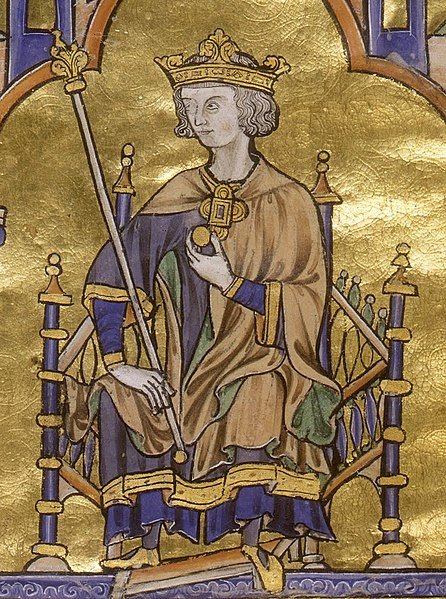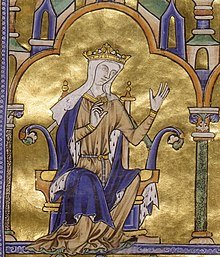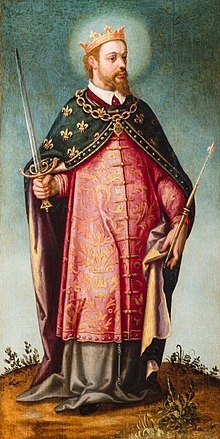Louis IX of France: Life and Major Accomplishments of the Saint King

Louis IX of France, also known as Louis the Saint, ruled France for over four decades, i.e. from 1226 to 1270. His coronation ceremony took place on November 29, 1226.
King Louis IX’s name blazons as a beacon of virtue in the history of Catholicism and the French monarchy. His reign is said to have coincided with the golden age for France, a time when the country was going through the peaks of economic, military and social power.
Known in the annals of history as the Saint King, Louis the Ninth may not have possessed the same military acumen the characterized great warrior kings like Richard the Lionheart. However, he distinguished himself by his strict adherence to moral values, all of which are as meaningful today as they were in the 13th century.
A major highlight of Louis’ rule was the relative peace France enjoyed. Where other monarchs were quick to pull the sword, this French king would rather settle territorial disputes through diplomacy.
In 2021, defenders of the Catholic faith clashed with protesters over a statue of Louis IX erected in Forest Park at St. Louis in Missouri, USA. An organizer of the protest said that the statue was a symbol of hate, bigotry and division and must be brought as down. A criminal investigation was launched shortly after the incident to look into the issue.
Minority years
Around the age of 12, Louis found himself at the helm of France’s affairs. This unexpected turn of events was thrust upon his young shoulders when his father, Louis VIII, died of dysentery after only 3 years of reign. Luckily, his pious half-English mother, Queen Blanche of Castile, was there to help him find his feet in a terrain almost new to him, but all too familiar to her.
Louis was number 4 of the 11 children of King Louis VIII and Queen Blanche. His paternal grandfather was Philip II of France and his maternal grandfather was Alfonso VIII, King of Castile and Toledo.
The young prince became heir to the French throne when his 3 older brothers – Philip, and the twins Alphonse, and John – died in 1218 and 1213, respectively.

Louis’ mother – Queen Blanche of Castile – was the third daughter of Alfonso VIII, King of Castile, and Eleanor of England. What this means is that his maternal grand uncles were King Richard I of England and King John of England. Queen Blanche served as regent twice during the reign of her son, Louis IX. First, during his minority from 1226 until 1234, and second, during his absence from 1248 until 1252.
The influence of Queen Blanche of Castile
On his 21st birthday, Louis was ripe to take over the reins as king, and his mother’s role shifted from regent to counselor. Nevertheless, she continued to wield an inestimable influence, not only on the political life of her son but his spiritual life as well. It was Queen Blanche who taught Louis to live a life of self-denial and prayer. It was also Blanche who instilled in the young king the most-prized ideals of kingship in France. It was even the valiant Blanche who had fought off the French barons keen on taking back the lands her deceased husband had seized from them.
In fact, Louis might have been in the driver’s seat of France, but it was Blanche who truly steered the affairs of the kingdom. Louis lent support to Christianity because he realized it established his religious legitimacy over his power to rule. It also sealed the right of succession he already owned.
Marriage to Margaret of Provence
In early 1234, at age 19, Louis married Margaret of Provence, the sister of Eleanor of Provence (the wife of Henry II of England) in a lavish ceremony held at the cathedral of St. Etienne. Margaret was crowned queen of France the following day.
Of course, Queen Blanche had engineered the affair although the papacy had fanned its flamed. Historians hint that Blanche resented Margaret after a while, but the actual reason for Blanche’s coldness toward her daughter-in-law has been widely speculated by archivists and chroniclers alike.
Blanche might have felt slighted for being alienated from her dominant role as Louis’ confidante. Or perhaps, the queen had started to see Margaret as competition, both battling for Louis’ affection. Plain old jealousy of the beauty and intelligence of the younger queen could have driven Blanche’s actions, perhaps. After all, legend has it that Margaret was a pretty face with dark hair and a matching set of dark eyes.
One thing was obvious; Blanche hated to assume the role of a dowager queen (titular queen) and blamed Margaret for it. Over the years, it seemed that every effort Blanche made to keep the young couple apart, only served to make the marriage solid. Queen Blanche eventually died 1252, aged 64.
Six years after reciting her wedding vows, Queen Margaret gave birth to her first child called Blanche, named after her mother-in-law. The young child died four years later. Louis and Margaret had 10 more children in the subsequent years, with 9 surviving to adulthood.
The Seventh Crusade
Louis IX was a staunch defender of his Catholic faith. He upheld the tenets of Catholicism with the enthusiasm of someone who believed he was God’s chosen and anointed. This arduous allegiance to Christendom was the major difference between Louis and most of his contemporaries.
In fact, history recalls that during his coronation (on November 29, 1226), Louis IX made a solemn vow to serve God with all his heart, and to be loyal to his subjects as a father would. He also swore an oath to be a feudal king for the gospel of Christ. As a natural consequence of his piety, Louis decided to go on on his first crusade when he received news of the Turkmen invasion of Jerusalem.
In 1248, at age 30, Louise left his mother in charge of France and embarked on a crusade to the Middle East – the Seventh Crusade, which came to be known as the “Crusade of St. Louis to the Holy Land.”
In order to understand Louis’ impassioned involvement in the Crusades, it is worthy to note that the primary aim of these wars was to take back Christian lands that had been seized by Muslims. The crusades were also means to secure the safety of the pilgrims traveling to the Holy Land.
In 1248, Louis IX led an army to the Mediterranean country of Cyprus where he linked up with about 200 English knights. The following year in June, they arrived in Egypt and captured the port city of Damietta (present day capital of the Damietta Governorate in Egypt). This was at a time when As-Salih Ayyub, the Sultan of Muslim Ayyubid Empire, was reportedly struck with a terminal illness. However, nature itself seemed to be against Louis and his army. The summer heat and the Nile River Delta, which had suddenly turned tumultuous, slowed down the movement of the French Crusaders as they tried to advance towards Cairo. Worse, the Crusaders failed to maintain discipline and went on a pillage rampage. They were also struck with plague in their camp.
Why was Damietta important to Louis IX and his Western crusaders?
Throughout the 12th and 13th centuries, the Egyptian port city of Damietta was really important to Western crusaders. This was because anyone who controlled Demietta controlled the Nile. Also, the port city was seen as a good launching pad to invade Egypt. In between the Second and Third Crusades, around 1169, Christian forces from the Kingdom of Jerusalem sent a fleet, with support from the Byzantine Empire, to capture the port. However, their attack was repelled by a fierce Muslim resistance led by Saladin, the a Muslim warrior and founder of the Ayyubid Dynasty. Similarly, the Western forces focused on Damietta during the Fifth Crusade (1217-1221). In 1219, the Crusaders managed to capture Damietta after a very hard-fought siege.
-
The Battle of Mansurah
Eventually, in the early part of 1250, a pontoon bridge was constructed on the Nile to aid the capture of Mansurah. Shortly after, the Battle of Mansurah (in modern-day Mansoura in Egypt) ensued between the French army and the Ayyubid army (led by the wife of the then deceased As-Salih Ayyub.) The four-day battle resulted in the death of most of Louis’ men.
Following the resounding defeat of the Crusader army, Louis IX and the surviving men were taken and imprisoned. The French king’s sense of moral uprightness became the object of his captors’ admiration in the ensuing days. Louis was eventually freed together with his men. However, some conditions had to be met first: Louis had to give up Damietta and a large ransom had to be paid to his Muslim captors.
-
Kingdom in Jerusalem
King Louis IX spent 4 years in the Frankish Kingdom of Jerusalem that had been founded in the Levant after the successful First Crusade (1096-1099). There, he helped the neighboring crusader states to reinforce their defensive systems. During this time, Louis also held talks with the Muslim leaders of Syria and Egypt. By 1254, he and his men had arrived back in France.
The Eighth Crusade & Louis’ Death
Much like its predecessor, the Eighth Crusade (aka the Second Crusade of Louis IX) in 1270 was aimed at recovering the holy sites in Levant (including Jerusalem) that had been captured by the Muslims. The idea of the Eight Crusade was birthed after 16 years of the Seventh Crusade. However, issues leading up to the crusade led to its ultimate abandonment.
Louis had successfully led his army to Tunis (present-day Tunisia) to face off against the Hafsid dynasty. Soon after arriving, he and his forces were stricken with disease. Many deaths were recorded even before the holy war began. Louis was believed to have grown extremely weak from long periods of fasting and prayer towards the victory of the Eight Crusade. French forensic pathologist Philippe Charlier writes, “…he put himself through all penances and fasted, nor was the crusade as well prepared as it should have been…”
Soon after landing on the shores of Tunisia in 1270, Louis died of dysentery. With their leader dead and with no definite plan, the stranded French soldiers forsook the crusade altogether, struck the Treaty of Tunis with the Hafsids, and then returned home to France.
Louis IX was succeeded by his son Philip III of France.

Also known as the Second Crusade of Louis IX, The Eighth Crusade was launched in 1270 by the Louis. It was aimed at the Hafsid dynasty in Tunisia. As a result, some historians termed it as the Crusade of Louis IX Against Tunis. It was during this military campaign that the renowned French monarch died. The cause of death was dysentery. With Louis gone, the Crusaders decided to negotiate a peace treaty, i.e. the Treaty of Tunis, with the Hafsids. The Crusaders then packed up and went back to Europe soon after. Image: Equestrian statue of Louis IX of France, also known as Saint Louis, at the Sacré-Cœur in Paris, France
Did you know…?
Similar to his father, Louis VIII, and his son, Philip III of France, Louis IX died of dysentery.
Accomplishments of Louis IX
The following are some of the major feats chalked by France’s Louis IX:
Louis reigned at a time when France influenced ideologies throughout Europe. The country was also regarded as the protector of the Catholic Church, and the French monarchy was revered as the Primus inter pares or “the first among equals” of the kings of Europe.
Against this backdrop, Louis’ moral values enjoyed immense admiration in Western Christendom. Armed with this prestige, he started peace negotiations with Henry III of England who was married to Eleanor of Provence, Louis’ sister-in-law.
A peace treaty was finally signed after many years of lengthy discussions. In spite of Louis’ superior power and influence, he gave Henry III Aquitaine and the surrounding lands. Henry III, on his part, proclaimed himself a villein of the French King in appreciation for his generosity.
Louis also focused much attention on the development of arts and literature throughout France. Much of the French arts influenced Gothic arts and architecture. Again, the French monarch is said to have supervised the establishment of many notable Parisian buildings, including the Sainte-Chapelle (within the royal palace of Paris) and the Palais de la Cité.

A bas-relief of St. Louis in the chamber of the United States House of Representatives.
Thanks to Louis’ encouragement, French scholar Vincent de Beauvais wrote a major encyclopedia called the Speculum majus between 1240 and 1260. This book was likely the most acclaimed European encyclopedia up to the 18th century.
Thirdly, Louis employed the services of royal investigators to look into the misdeeds of some of the officials in his administration. This led to the creation of important ordinances in 1254 and 1256 which clarified the duties and responsibilities of royal officials. The ordinances also prohibited the officials from visiting the pubs and gambling places. Louis enforced penalties on such acts as counterfeiting in order to maintain the stability of the France’s currency.
The philanthropic Louis IX was praised for showing the utmost dedication to his people by launching a number of social interventions. He built many hospitals and facilities to care for the needy and the sick. According to some historical accounts, he invited some of the poor folks in his kingdom to eat with him almost every day of his reign.
Lastly, Louis became a patron of the Secular Franciscan Order. This was a Catholic Order which sought to observe the Gospel of Jesus by following the example of its founder, Francis of Assisi (later patron saint of animals and the environment, and one of the patron saints of Italy).
Louis IX was able to maintain peace throughout the nation for many years. This he achieved through his efforts to unify the noble men and his countrymen as well as the priests and peasants.
Why was Louis IX proclaimed a saint?

Seen by his contemporaries as a model of a very pious Christian monarch, Louis IX was proclaimed a saint by Pope Boniface VIII in 1297. Image: San Luis, Rey de Francia by Spanish painter Francisco Pacheco
About two decades after his death, in August 1297, King Louis IX was canonized as Saint Louis IX by Pope Boniface VIII. The ceremony was held as part of the reconciliation process of the phase one of the conflict between Boniface and Phillip IV of France. Even to this day, people still gather at St. Louis’ tomb to pray.
Louis holds a distinguished place in the history of France as he is the only French king to attain sainthood.
Conclusion
True. Louis could very well be voted as one of the greatest kings in the history of French monarchy for his respect for papacy and kind heartedness. There were more than enough socio-economic and cultural progress during his 44-year old reign (1227 to 1270) put him atop his contemporaries.
However, like all rulers, Louis the Ninth had his own imperfections. There are legendary accounts that testify of his quick temperedness and overly aggressive behavior towards his ministers and courtiers.
The French king was also known for his brutal measures aimed at keeping the excesses of the clergy in control. But then again, these flaws pale in comparison to his devotion to the Church and to his kingdom as a whole.
























